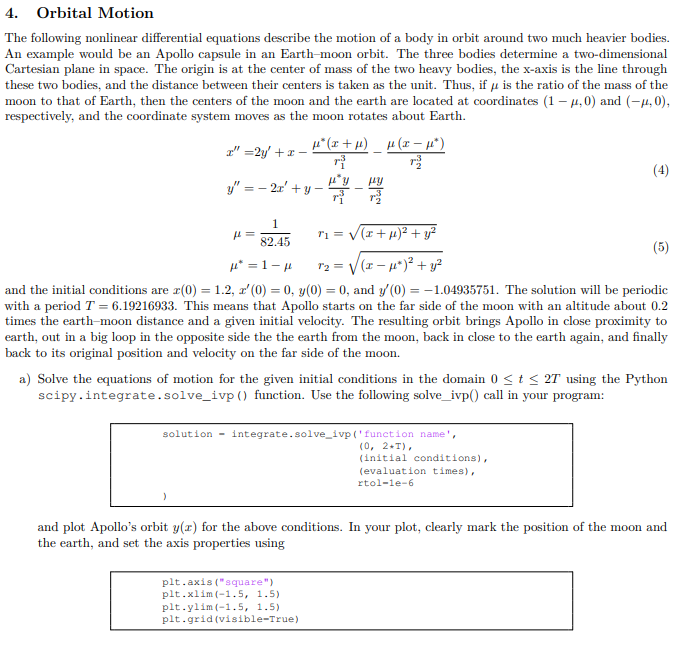Answered step by step
Verified Expert Solution
Question
1 Approved Answer
4. Orbital Motion The following nonlinear differential equations describe the motion of a body in orbit around two much heavier bodies. An example would


4. Orbital Motion The following nonlinear differential equations describe the motion of a body in orbit around two much heavier bodies. An example would be an Apollo capsule in an Earth-moon orbit. The three bodies determine a two-dimensional Cartesian plane in space. The origin is at the center of mass of the two heavy bodies, the x-axis is the line through these two bodies, and the distance between their centers is taken as the unit. Thus, if is the ratio of the mass of the moon to that of Earth, then the centers of the moon and the earth are located at coordinates (1-,0) and (-,0), respectively, and the coordinate system moves as the moon rotates about Earth. x"=2y+x- y" = -2x+y * (x+) (x *) (4) == 1 f= T = (x+)+ y 82.45 fl* = 1-pl T2 = (x *) + y (5) and the initial conditions are (0) = 1.2, x'(0) = 0, y(0) = 0, and '(0) = -1.04935751. The solution will be periodic with a period T = 6.19216933. This means that Apollo starts on the far side of the moon with an altitude about 0.2 times the earth-moon distance and a given initial velocity. The resulting orbit brings Apollo in close proximity to earth, out in a big loop in the opposite side the the earth from the moon, back in close to the earth again, and finally back to its original position and velocity on the far side of the moon. a) Solve the equations of motion for the given initial conditions in the domain 0 < t < 27 using the Python scipy.integrate.solve_ivp() function. Use the following solve_ivp() call in your program: solution - integrate.solve_ivp('function name', (0, 2+T), (initial conditions), (evaluation times), rtol-le-6 and plot Apollo's orbit y(x) for the above conditions. In your plot, clearly mark the position of the moon and the earth, and set the axis properties using plt.axis ("square") plt.xlim (-1.5, 1.5) plt.ylim (-1.5, 1.5) plt.grid(visible-True) b) Try half and double the initial velocity and plot the resulting orbits for 0
Step by Step Solution
There are 3 Steps involved in it
Step: 1

Get Instant Access to Expert-Tailored Solutions
See step-by-step solutions with expert insights and AI powered tools for academic success
Step: 2

Step: 3

Ace Your Homework with AI
Get the answers you need in no time with our AI-driven, step-by-step assistance
Get Started


